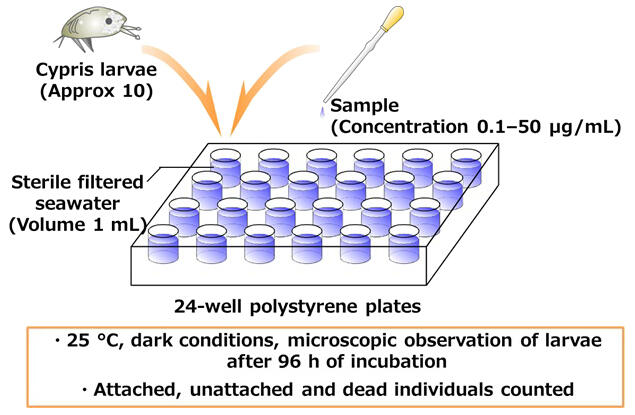A research group led by Associate Professor Hiroyoshi Takamura and Professor Isao Kadota from the Graduate School of Environmental, Life, Natural Science and Technology, along with Graduate Students Yuki Sugitani and Ryohei Morishita from the Graduate School of Natural Science and Technology at Okayama University, and Associate Professor Takefumi Yorisue from the Institute of Natural and Environmental Sciences at the University of Hyogo, has announced their successful chemical synthesis of "scabrolide F," a natural organic compound isolated from soft corals. Furthermore, they found that it has an inhibitory effect on the adhesion of the barnacle Amphibalanus amphitrite. Because it only inhibits adhesion and does not exhibit toxicity, it is expected to find application as an effective and environmentally friendly antifouling agent. The results were published on May 23 in Organic & Biomolecular Chemistry, a journal of the Royal Society of Chemistry, UK.

Provided by Okayama University
When biofouling organisms such as the Korean mussel Mytilus unguiculatus, bryozoans and acorn barnacles (Balanomorpha spp.) adhere to the bottom of ships, they increase seawater resistance, leading to decreased vessel fuel efficiency and increased greenhouse gas emissions. These organisms also adhere to the water intake and drainage systems of coastal power plants and other waterfront facilities, reducing the efficiency of cooling systems. Currently, several heavy metals and organic compounds are used as antifouling agents, but these biocidal agents have adverse effects on the environment.
The research group evaluated the biological activities of the synthesized scabrolide F and six related compounds against A. amphitrite (cypris larvae). The results confirmed that these compounds inhibited attachment with a 50% effective concentration (EC50) of 2.65−9.46 µg/mL. None of them showed toxicity at a concentration of 50 µg/mL.
Takamura said, "Damage caused by biofouling is a global problem. Our group is synthesizing and evaluating compounds with inhibitory effects on biofouling organisms. In this study, our graduate students Sugitani and Morishita synthesized a natural organic compound called scabrolide F and related compounds while overcoming various challenges. Dr. Yorisue, my collaborator, provided A. amphitrite cypris larvae, which I used for studying the compounds' antifouling effects. It was truly a team effort. I hope that more researchers will participate in this area of research and that problems caused by biofouling will be solved at the molecular level."
Journal Information
Publication: Organic & Biomolecular Chemistry
Title: Total synthesis and structure-antifouling activity relationship of scabrolide F
DOI: 10.1039/d4ob00698d
This article has been translated by JST with permission from The Science News Ltd. (https://sci-news.co.jp/). Unauthorized reproduction of the article and photographs is prohibited.




